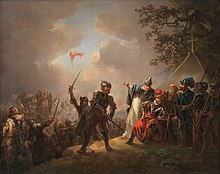
Back معركة ليندانيس Arabic Бітва пры Лінданісэ Byelorussian Битка при Линданисе Bulgarian Bitva u Lyndanisse Czech Slaget ved Lyndanisse Danish Schlacht von Lyndanisse German Batalla de Lyndanisse Spanish Lindanise lahing Estonian نبرد لیندانیسه Persian Lyndanisen taistelu Finnish
| Battle of Lindanise | |||||||
|---|---|---|---|---|---|---|---|
| Part of the Northern Crusades | |||||||
 Dannebrog falling from the sky during the Battle of Lindanise. Painting by C.A. Lorentzen, 1809. | |||||||
| |||||||
| Belligerents | |||||||
|
Revala Harjumaa | |||||||
| Commanders and leaders | |||||||
| Unknown |
Valdemar II Anders Sunesen Witslaw of Rügen Albert of Saxony Theoderich von Treyden † | ||||||
| Strength | |||||||
| 1,000–2,000 | Unknown | ||||||
| Casualties and losses | |||||||
| Several thousand | Unknown but heavy | ||||||
The Battle of Lyndanisse or Lindanise[a] was fought on 15 June 1219 during the Northern Crusades, between the forces of the invading Kingdom of Denmark and the local non-Christian Estonians. The Danish victory in the battle, at the site of the later Hanseatic city of Reval (now Tallinn, Estonia) helped King Valdemar II of Denmark to subsequently claim the territory of northern Estonia as his participation in the crusade into Estonia had been undertaken in response to calls from the Pope.[1]
The 1219 Battle of Lyndanisse is still well known to this day, especially amongst Danes and Estonians, because of a popular legend about the first ever Danish flag, the Dannebrog, which allegedly fell from the sky, as an apparently helpful divine intervention, just when the Danish Crusaders were about to lose the battle to the local pagans.
Cite error: There are <ref group=lower-alpha> tags or {{efn}} templates on this page, but the references will not show without a {{reflist|group=lower-alpha}} template or {{notelist}} template (see the help page).
- ^ "Danish Flag (FYI Denmark)". Archived from the original on 2012-03-13. Retrieved 2010-10-01.